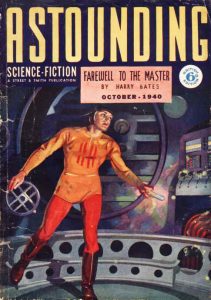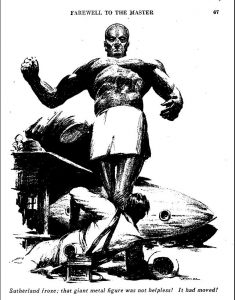 “Farewell to the Master”
“Farewell to the Master”
Harry Bates
The Day the Earth Stood Still
Harry Bates was the first editor of Astounding Stories of Super-Science, known as Analog today. He was born on this date, October 9, in 1900.
Astounding Stories of Super-Science was the second science fiction pulp, intended as a competitor of Hugo Gernsback’s Amazing Stories. Bates is credited with infusing a sense of action and adventure into the field, in contrast to the stuffy, intellectual type of story favored by Gernsback. I’m going to have to read some of those stories and report back.
 Today I want to look at the reason Bates is remembered today. That’s his story “Farewell to the Master”, which became the basis of the 1951 film The Day the Earth Stood Still. Spoiler: the movie is very different from the story.
Today I want to look at the reason Bates is remembered today. That’s his story “Farewell to the Master”, which became the basis of the 1951 film The Day the Earth Stood Still. Spoiler: the movie is very different from the story.
A quick summary (with no more spoilers): a craft appears on the lawn of the Smithsonian. It doesn’t descend. It just appears out of nowhere. A few days pass, and crowds gather. Then a man steps out of the craft accompanied by a large green robot. He says his name is Klaatu and the robot is Gnut. Before he can say anything else, he is shot dead by a person in the crowd.
Klaatu is buried in the Tidal Basin. Gnut doesn’t move or say anything. An entire wing of the Smithsonian is built around the robot and the ship. In three months. This part I didn’t buy. Humanity being the type they are, they do everything to make sure the robot is rendered inoperable.
 The reporter named Sutherland (who broke the story because he was the only reporter nearby the day the ship appeared) is covering the opening of the wing when he notices something. The robot’s foot is in a slightly different spot than it was the day before. He decides to sneak into the museum that night to see what happens.
The reporter named Sutherland (who broke the story because he was the only reporter nearby the day the ship appeared) is covering the opening of the wing when he notices something. The robot’s foot is in a slightly different spot than it was the day before. He decides to sneak into the museum that night to see what happens.
You’ll have to read the story yourself to fins that out.
I read this story back in [REDACTED] when I was in high school. Tonight was the first time I’ve read it since. There’s a danger in rereading the stories that you enjoyed in your youth. I was pleased to find out “Farewell to the Master” has held up well. The writing is a bit rough in a couple of spots, but overall the story is well-told. Other than building an entire wing of a museum in less than three months, the only thing I had difficulty buying into was the totally lax security at the museum. The technology was primitive by today’s standards, but that I can deal with.
“Farewell to the Master” is ultimately a sad story. It was more moving than I remembered. The twist in the final line shouldn’t be much of a surprise to anyone who has a lot of fiction, but it’s still effective. This one is worth reading.

I have never read it but I want to now.
I think you would like it.
Under a pseudonym, Bates was one on the authors of the Hawk Carse stories. These stories are often thought to be the first western-story-rewritten-as-science-fiction. Maybe so, maybe not, but they are certainly good pulpy fun.
I have heard that. I’m going to have to look them up.